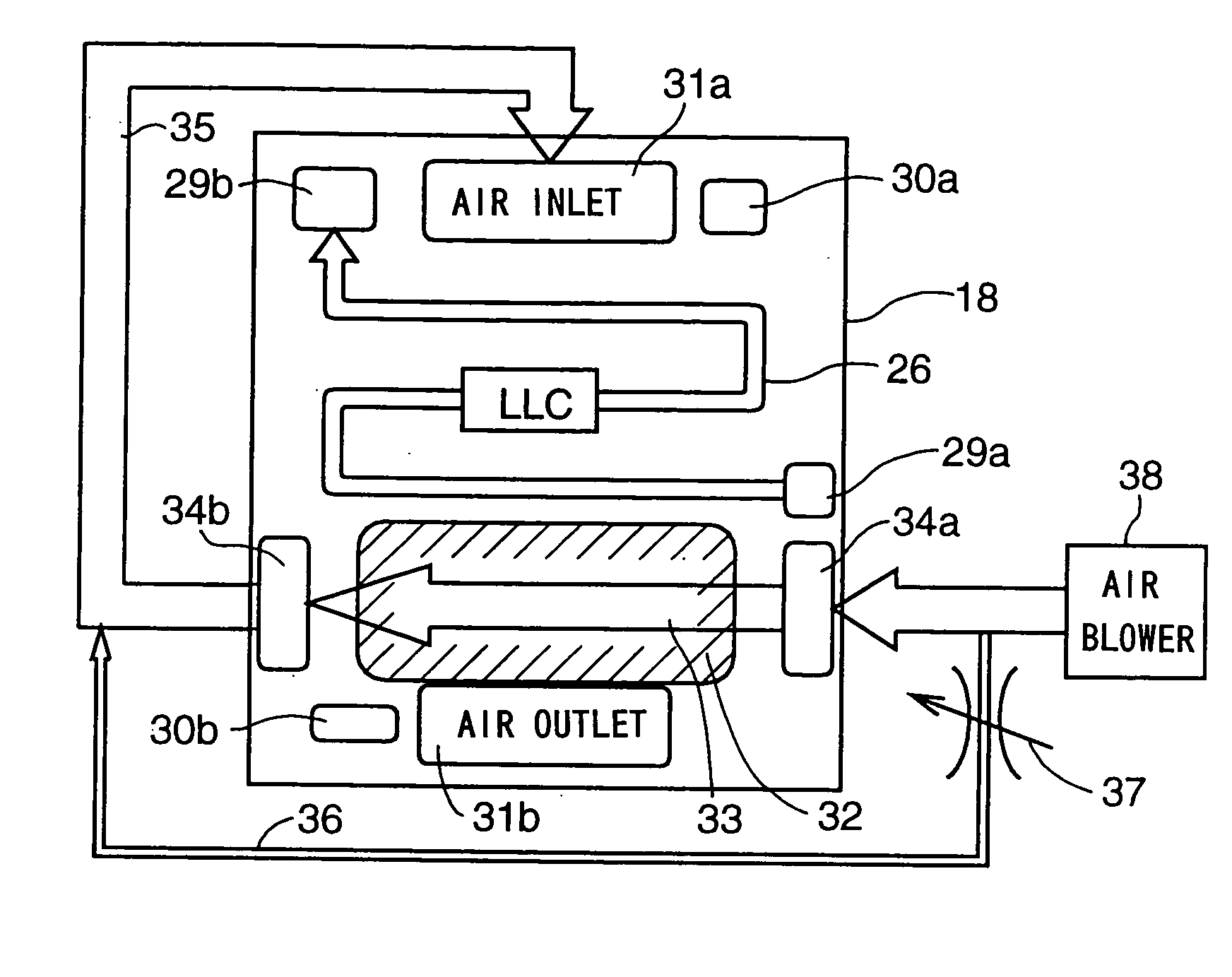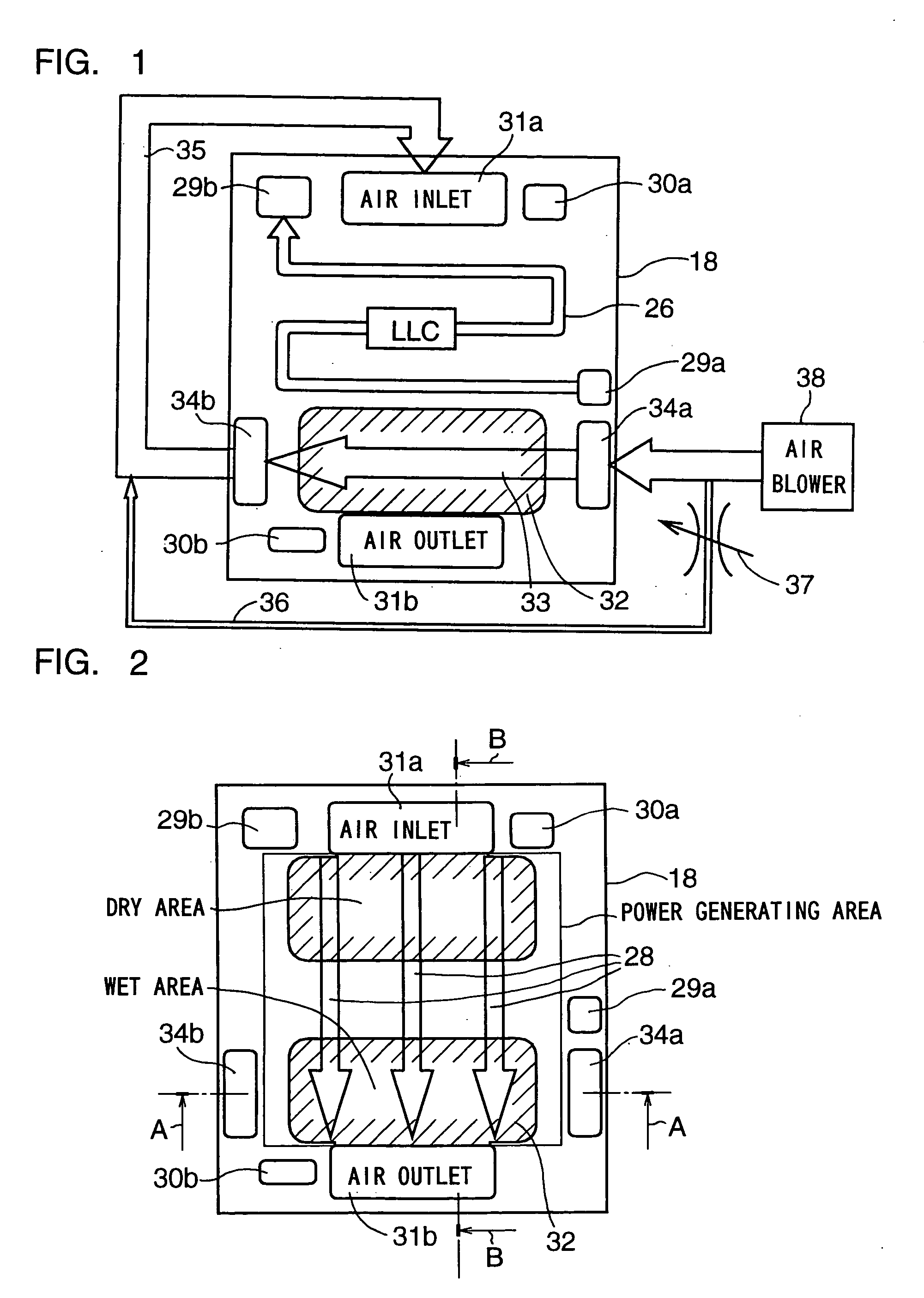Fuel cell
- Summary
- Abstract
- Description
- Claims
- Application Information
AI Technical Summary
Benefits of technology
Problems solved by technology
Method used
Image
Examples
embodiment 1
[0086] With embodiment 1 of the present invention, as is illustrated in FIGS. 1-4, the cooling gas passage 33 of the separator 18 is fluidly connected to a blower 38 on an upstream side of the cooling gas passage 33. A discharging port of the blower 38 is fluidly connected to the cooling gas supply manifold 34a, and an intake port of the blower 38 communicates with a cooling gas source (atmosphere). The cooling gas circuit communicates with the reactant gas supply passage 30a, 31a (into the oxidant gas supply manifold 31a) on the downstream-side of the cooling gas passage 33 via the connecting passage 35. No blower is provided in the connecting passage 35. The cooling gas is used for the reactant gas as it is. In FIG. 1, the cooling gas is air.
[0087] At a downstream portion of the reactant gas passage 27, 28 (the oxidant gas passage 2 in the illustrated example), a porous portion 32 is formed. At the MEA opposing surface of the porous portion 32, the reactant gas passage 27, 28 is f...
embodiment 2
[0089] With embodiment 2 of the present invention, as is illustrated in FIG. 5, a blower 38 is disposed in the connecting passage 35 which connects the cooling gas passage 33 and the reactant gas supply passage, on the downstream side of the cooling gas passage 33. A discharge port of the blower 38 is fluidly connected to the reactant gas supply manifold 30a, 31a, while an intake port of the blower 38 is fluidly connected to the cooling gas exhaust manifold 34b. The cooling gas circuit is connected to the reactant gas supply manifold 30a, 31a (the oxidant gas supply manifold 31a in the illustrated example) on the downstream side of the cooling gas passage 33, via the connecting passage 35 and the blower 38. No blower is provided on an upstream side of the cooling gas passage 33. The cooling gas is used as reactant gas as it is. In the example of FIG. 5, the cooling gas is air.
[0090] At a downstream portion of the reactant gas passage 27, 28 (the oxidant gas passage 28 in the illustr...
embodiment 4
[0095] With embodiment 4 of the present invention, as illustrated in FIG. 7, the porous portion 32 is formed in the anode-side separator 18. The fuel gas passage 27 is formed at one surface of the porous portion 32, and the cooling gas passage 33′ is formed at the other surface of the porous portion 32. Fuel gas (e.g., hydrogen) flows in the cooling gas passage 33′. In a cathode-side separator of an adjacent fuel cell, a cooling gas passage 33 is formed at a surface opposite to an MEA opposing surface where an oxidant gas passage 28 is formed, of the separator of the adjacent fuel cell. The cooling gas passage 33 of the adjacent fuel cell is not partitioned from the cooling gas passage 33′ of the instant fuel cell, and fuel gas (e.g., hydrogen) flows the cooling gas passage 33 of the adjacent fuel cell. In the cathode-side separator of the adjacent fuel cell, a separator portion between the oxidant gas passage 33 at one surface of the separator and the cooling gas passage 33 at the ...
PUM
 Login to View More
Login to View More Abstract
Description
Claims
Application Information
 Login to View More
Login to View More - R&D
- Intellectual Property
- Life Sciences
- Materials
- Tech Scout
- Unparalleled Data Quality
- Higher Quality Content
- 60% Fewer Hallucinations
Browse by: Latest US Patents, China's latest patents, Technical Efficacy Thesaurus, Application Domain, Technology Topic, Popular Technical Reports.
© 2025 PatSnap. All rights reserved.Legal|Privacy policy|Modern Slavery Act Transparency Statement|Sitemap|About US| Contact US: help@patsnap.com



